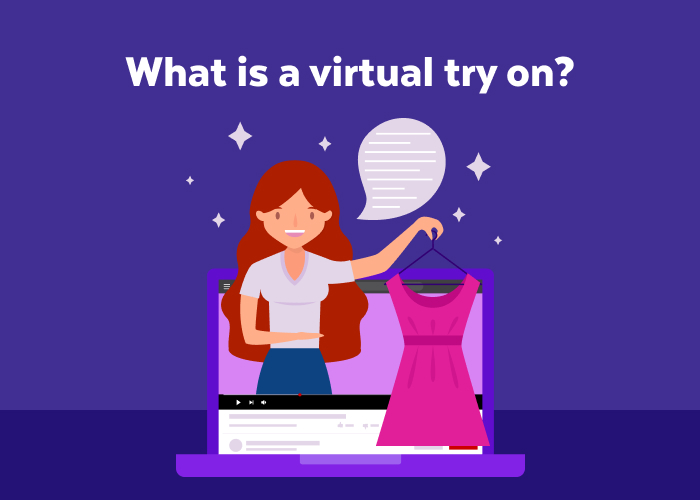What is a virtual try on?

Virtual try on is a modern technology that allows customers to digitally visualize how a product will look on them before making a purchase. It typically involves using augmented reality or artificial intelligence to overlay virtual representations of products onto images or videos of the user. This gives users an immersive and interactive experience.
For example, in the fashion industry, virtual glasses try on allow users to see how glasses would look on their own face by superimposing virtual images of different glasses onto live images or uploaded photos or videos of themselves. Similarly, in the beauty industry, virtual hair color try on enables users to virtually try on hair colors to see how they would look on their hair and face.
Thus, it not only enhances the overall e-commerce shopping experience but also reduces the likelihood of returns. Furthermore, it increases customer satisfaction and ensures that customers are confident in their purchasing decisions.
What are the use cases of virtual try-on?
Optics
Customers can virtual try on glasses to examine how various frames would appear on their faces, which helps them make better selections when selecting sunglasses or spectacles. Virtual try-on tools facilitate users’ exploration of a vast array of frames.
Clothing
Clothing is one of the most well-known use cases for virtual try-on technology. Within the fashion sector, virtual try on clothes let users preview how clothes will fit and appear on their body types, assisting them in selecting the appropriate size and style.
Home Decorations
The furniture and decor industry is one of the most prominent use cases for virtual try-ons. Before placing an order, users may digitally arrange furniture and other design items in their living area with the help of these applications, which let them see how different objects will fit and appear.
Tourism
Different kinds of virtual trying-on apps have the power to completely transform the travel and tourism sector. It gives users an immersive vacation planning and location exploration experience. By utilizing augmented reality technology, these applications provide virtual tours of hotels. This enables users to virtually experience various types of lodgings and activities prior to making a reservation.
Jewelry
Buyers can preview how various jewelry items, such as pendants, earrings, and rings, would seem on them when they wear them. This helps buyers select the ideal design for any event.
Makeup
With the help of virtual reality applications, users can virtually put on different cosmetic items, trying different tints and looks to discover the ideal combination without the need for real trials. Furthermore, the powerful AR technology used by the beauty and cosmetics app enables users to experiment with various cosmetic items, such as base colors, shade tones, and glosses.
How to Develop a Virtual Reality App?
Developing a virtual reality app involves several steps, from conceptualization to deployment.
- Firstly, determine the purpose and goals of your VR app. Identify your target audience and what experience you want to create for them.
- Thereafter, decide which VR platform you want to develop. Some popular options include Oculus Rift, PlayStation VR, and mobile VR platforms like Google Cardboard, etc.
- Depending on the platform you choose, you’ll need different development tools and languages.
- Familiarize yourself with the specific requirements and techniques for VR development.
- Create the 3D models, textures, and animations for your VR environment. Consider factors like scale, immersion, and comfort to ensure a compelling and comfortable experience for users.
- Develop methods for users to interact with the VR environment, such as hand controllers, gaze-based interactions, or gestures. Ensure that interactions feel natural and intuitive within the VR context.
- VR applications require high performance to maintain a smooth and immersive experience. Optimize your app for performance by reducing unnecessary rendering, optimizing assets, and minimizing latency.
- Once your VR app is ready, distribute it through the appropriate channels for your chosen platform.
- Continuously support your VR app by addressing user feedback, fixing bugs, and providing updates with new features or improvements. Building a community around your app can also help maintain its longevity.
Conclusion
By bridging the gap between online and physical retail, virtual try on technology delivers substantial benefits to the shopping experience, including ease, customization, and confidence in purchase decisions. Virtual try-on lowers uncertainty, boosts engagement, and creates a more engaging and pleasurable buying experience. It should become a crucial component of online buying in the future as merchants keep investing in and improving this technology, transforming the way customers browse, assess, and eventually buy things.
FAQs
Is virtual try-on technology accurate?
What types of products can be tried on virtually?
How does virtual try-on benefit retailers?
Are there any privacy concerns with virtual try-on technology?
Can virtual try-ons be integrated into mobile apps?
Ravi Bhojani is the Chief Marketing Officer (CMO) at Alian Software, where he spearheads the company’s marketing strategies and drives its brand presence in the competitive IT services landscape. With over a decade of experience in the technology and marketing sectors, Ravi has consistently demonstrated his ability to blend innovative marketing techniques with deep industry knowledge to deliver outstanding results.